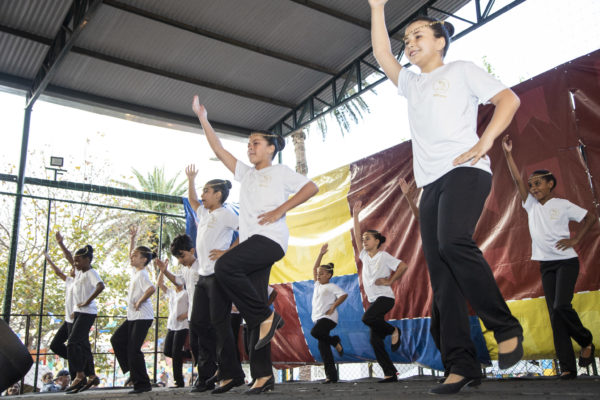São Paulo – An institution established by Syrian immigrants in 1923 in Brazil has become a benchmark for measuring the social impact of actions of the third sector. As the São Paulo-based community center Lar Sírio Pró-Infância turns 100, it adopts five-year strategies to bring the work it develops into modern times, despite the longevity of its activity. The creation of methodologies and technologies to measure the results from social works is part of this strategy. Pictured above, children at arts activities at Lar Sírio.

In an interview with ANBA on the occasion of the 100th anniversary, the institution’s chairman Sergio Stephano Chohfi Filho and superintendent Elaine Bueno Silva spoke of the gains the Lar Sírio Pró-Infância has obtained both from its strategies for measuring the results of the third sector, which was the focus of the 2018-2023 five-year period, and the mission of providing services and protection for children and adolescents in vulnerable situations by offering integrated development opportunities and creating better life prospects for them.
The goal to be a benchmark for measuring social results took shape in the past five years, and now Lar Sírio offers evaluation culture courses for organizations. “We share our methodology, our technology with them for them to replicate it in their own institutions,” explains Silva. The methodology and the technology were developed in-house by the disciplinary body and found a third sector in need of this solution.
Lar Sírio has encountered a favorable moment for its work in the corporate market’s shift towards environmental, social and corporate governance (ESG). “Companies join us much more often than they used to as they have to be engaged in ESG programs. It’s a favorable ground,” said Chohfi.

The institution holds many actions in partnership with the private sector and plans social governance activities according to the demands of the companies. Agricultural giant Cargill has an environmental area inside Lar Sírio, the Roça Cargill, where children can experiment with plantations. The company is also a partner in supporting a bakery in the institution, where snacks are made for the children, and bread-making and confectionary courses are given to students and their parents.
The strategy the institution has adopted for the upcoming five-year period from 2023 to 2028 is guided by this participation of companies in the Lar Sírio. That’s because the focus now is engaging the surrounding area, particularly the district of Tatuapé, where it’s seated, in the socio-educational work of the community center. “We want these people to come and provide social contributions with their companies or as individuals,” said Silva. The idea is to attract both small businesses and large companies and turn Tatuapé into a socio-educational district.

In this vein of looking at the current and future times the activities of Lar Sirio have unfolded day after day. The institution has gone through many chances since it was first established in 1923 by young immigrants from Homs. At first, it operated as an orphanage, known as Orphanato Syrio. Now the Lar Sírio is a community center that welcomes children and adolescents after and before class in an area of 25,000 sqm in Tatuapé.
Over 1,000 children in vulnerable situation and social risk, as well as 1,200 adolescents in training courses. The institution has an infrastructure of 18 buildings with learning environments in arts, culture, sports, leisure, and civility. But the idea isn’t being a school setting but a space where the little ones can live together, do the activities they choose – as few of them are mandatory – and find an emotional bond.
It’s part of the job to provide meals and nutritional counseling, psychological care, and social assistance for families – the latter in more critical cases together with the Juvenile Courts.
To join the Lar Sírio criteria like socioeconomic situation and vulnerability are considered, including living with alcoholism.

The work of Lar Sírio is focused on making the children and adolescents to move out from vulnerable situation and be empowered with their families. “It’s an interdisciplinary group working to empower this family,” said Silva. For training the adolescents, the center works with partners like the Social Service of Industry (SESI), which has a school in the premises and students from Lar Sírio.
The expenses of Lar Sírio Pró-Infância are covered through various sources. The most important of them is its equity income, that accounts for 75%, followed by partnerships with private institutions and donations, encompassing 20% of the income, and public funds at 5%, through the Center for Children and Adolescents (CCA). Occasionally there’re some other extemporaneous funds. The community center is always open to new collaborations and donations, as they can allow its services to expand.
To celebrate its 100th anniversary, the Lar Sírio is holding a series of activities this year. One was taking the children to places where Arab immigrants are present in São Paulo, including visits to the Arab Brazilian Chamber of Commerce (ABCC). A party was also held, and the ABCC was a sponsor. The schedule of celebrations also includes exhibits, workshops, storytelling, and other actions. The date of foundation of the institution is July 10, but activities are being held throughout the year.
Translation by Guilherme Miranda




